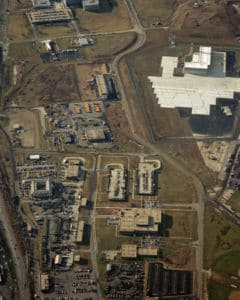There are five major microgrid market segments, each having particular characteristics depending on their function, location, and who or what operates them.
Commercial & Industrial Microgrids
Such facilities can range from a single story that can be an office or a warehouse through to large, complex and sophisticated mining or refining operations. These assets can be both brownfield (incorporated into existing facilities) or a new project that is developed on a greenfield site (currently undeveloped). If the latter case is true, there is usually more flexibility in how the microgrid is designed from the outset, but can come with challenges of having less certainty regarding the energy profile of the facility. A brownfield asset can be more complex in terms of integrating a microgrid with existing infrastructure but the energy profile and infrastructure on site can be known in detail. The main business drivers today for this type of microgrid are security of supply, reliability and power quality. These are important considerations to a company that may experience large revenue losses in the event of a power failure or power quality issues (which can severely impact the operational life of on site equipment). That said, operating costs are always a driver and with an increasing commitment to corporate social responsibility, emission reductions are quickly shifting from “nice to have” to a “must have”.

Institutional Microgrids
These microgrids often generate energy for a set number of buildings located within a defined geographical space, such as a corporate/university campus or other premises owned or run by a particular organization. They may be particularly attractive to universities which included research facilities where there may be sensitive samples that would be adversely impacted in the event of a power failure. For this reason, some of the most advanced microgrids in the world are operated by large research establishments, such as Princeton University and the University of Texas at Austin. The organization operating such a microgrid will often employ a single person responsible for making the main decisions. The microgrids serving each space will have to meet different requirements and will often have load priorities to ensure that the most critical loads always have power.
 Military Microgrid Operators
Military Microgrid Operators
Some microgrids may be operated by organizations serving or elements of the armed forces. This is usually the smallest of the various microgrid markets. However, it is a market that is often of prime importance to national security, as individual bases may rely on these microgrids for energy independence for enhanced resilience (often up to 2 weeks or more) and to improve cybersecurity in an age where military equipment is rapidly becoming highly technical. Some military microgrids are mobile, which means they can be deployed quickly and easily on a battlefield, in turn reducing the need for fuel to be transported over long distances to remote locations.
Community Projects And Utilities
These microgrids will primarily serve private residential customers alongside any commercial or industrial premises that may be located in a particular residential area. They may include central or distributed energy storage systems and be connected to the traditional centralized grid so that any excess energy can be exported, thus enabling consumers of energy to become ‘prosumers’. Decisions regarding the development of the microgrid and its operation may take longer because there will usually be more people participating in the project, complex interconnection process and more than one decision maker.

Remote Off-Grid Microgrids
These microgrids will be similar to community microgrids with the main difference being that they will not usually be connected to a utility national grid. They will instead operate as an “island” microgrid system, usually because of economic issues or their geographical location – they may be located some distance away from national transmission lines. Examples of remote microgrids are for communities in remote regions like Alaska, Western Australia or islanded nations around the world. Their main function will be reliability and resilience. Due to their remoteness system maintenance and access to parts can be challenging and needs to be considered when designing such a system This means that they will often be designed to operate autonomously and are even more likely than other microgrids to draw on distributed and diverse, generation technologies. This needs to be balanced with the microgrid needs and levelized cost of electricity (LCOE).
Photo credits: (Shane McLendon / Unsplash) (National Archives) (Patrick Schreiber / Unsplash)
